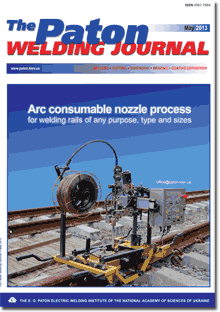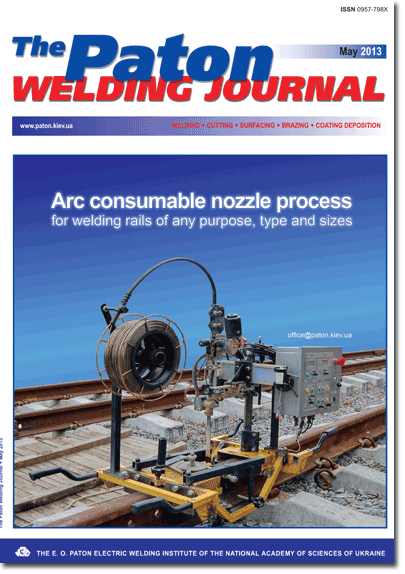| 2013 №05 (04) | 2013 №05 (06) |

The Paton Welding Journal, 2013, #5, 39-44 pages
PROPERTIES OF THE WELD METAL OF TWO-SIDED WELDED JOINTS ON PIPES MADE FROM INCREASED-STRENGTH MICROALLOYED STEELS
A.A. RYBAKOV, S.E. SEMYONOV and T.N. FILIPCHUK
E.O. Paton Electric Welding Institute, NASU, Kiev, Ukraine
Abstract
Two-pass two-sided welding is widely applied to manufacture large-diameter pipes for main gas and oil pipelines. It is obvious that metal of the welds that are the first to make is subjected to repeated heating in making the subsequent pass. The study is dedicated to evaluation of the effect of repeated heating on properties of the weld metal of the two-sided welded joints on pipes made from increased-strength microalloyed steels. Investigations were carried out on the weld metal of welded joints on the pipes made from ferritic-pearlitic steels of strength category K56-K60 and of different microalloying types (10(09)G2FB, 10G2FT, 10G2T, etc.). Impact toughness, hardness and peculiarities of structural characteristics of the inside weld metal of the welded joints on pipes subjected to repeated heating in making the outside weld were evaluated. It was shown that decrease in impact toughness of test specimens of the two-pass two-sided welded joints on the pipes, the tested section of which comprises the metal of intersection of the inside and outside welds, is caused by the presence of the local embrittlement zones forming in the inside weld metal due to its heating in making the outside weld. Investigations, including by transmission electron microscopy combined with microdiffraction, detected the following two zones present in the inside weld metal: low-temperature zone (heating to 450-650 °C) caused by occurrence of the dispersion hardening processes, and high-temperature zone (heating to 950-1100 °C) related to the MAC-phase containing a substantial amount of a more stressed lath martensite and forming as a result of decomposition of non-homogenised austenite. 8 Ref., 3 Tables, 6 Figures.
Keywords: gas and oil line pipes, welded joint, weld metal, repeated heating, impact toughness, hardness, structure
Received: 27.02.13
Published: 28.05.13
References
1. (2010) DNV-OS-F101: Offshore Standard Norkske Veritas. Submarine pipeline systems.
2. Ito, Y., Nakanishi, M. (1975) Study on Charpy impact properties of weld metals with submerged arc welding. IIW Doc. IX-A-113-75.
3. Farrar, R.A., Wong, S.Y., Watson, M.W. (1980) How stress relief affects SA weld metal containing niobium. Welding and Metal Fabr., 1/2, 21-23.
4. Yoshino, Y., Stout, R.D. (1979) Effect of microalloys on the notch toughness of line pipe seam welds. Welding J., 58(3), 59-69.
5. Frantov, I.I., Golovanenko, S.A., Moiseev, B.A. et al. (1981) Welding of thick-walled large-diameter pipes made from controlled rolling steel. Svarochn. Proizvodstvo, 6, 11-13.
6. Makarov, E.L. (1981) Cold cracks in welding of alloyed steels. Moscow: Mashinostroenie.
7. Garland, J.G., Kirkwood, P.R. (1975) Towards improved submerged arc weld metal. Metal Constr., 5, 275-283.
8. Denisenko, A.V., Grabin, V.F., Korsun, A.O. et al. (1990) Morphological peculiarities of structure of low-alloy weld metal and their effect on properties of welded joints. Avtomatich. Svarka, 10, 32-37.
Suggested Citation
A.A. RYBAKOV, S.E. SEMYONOV and T.N. FILIPCHUK (2013) PROPERTIES OF THE WELD METAL OF TWO-SIDED WELDED JOINTS ON PIPES MADE FROM INCREASED-STRENGTH MICROALLOYED STEELS. The Paton Welding J., 05, 39-44.The cost of subscription/purchase order journals or individual articles
| Journal/Currency | Annual Set | 1 issue printed |
1 issue |
one article |
| TPWJ/USD | 384 $ | 32 $ | 26 $ | 13 $ |
| TPWJ/EUR | 348 € | 29 € | 24 € | 12 € |
| TPWJ/UAH | 7200 UAH | 600 UAH | 600 UAH | 280 UAH |
| AS/UAH | 1800 UAH | 300 UAH | 300 UAH | 150 UAH |
| AS/USD | 192 $ | 32 $ | 26 $ | 13 $ |
| AS/EUR | 180 € | 30 € | 25 € | 12 € |
| SEM/UAH | 1200 UAH | 300 UAH | 300 UAH | 150 UAH |
| SEM/USD | 128 $ | 32 $ | 26 $ | 13 $ |
| SEM/EUR | 120 € | 30 € | 25 € | 12 € |
| TDNK/UAH | 1200 UAH | 300 UAH | 300 UAH | 150 UAH |
| TDNK/USD | 128 $ | 32 $ | 26 $ | 13 $ |
| TDNK/EUR | 120 € | 30 € | 25 € | 15 € |
AS = «Automatic Welding» - 6 issues per year;
TPWJ = «PATON WELDING JOURNAL» - 12 issues per year;
SEM = «Electrometallurgy Today» - 4 issues per year;
TDNK = «Technical Diagnostics and Non-Destructive Testing» - 4 issues per year.


